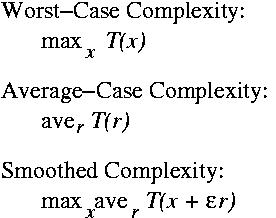Smoothed Analysis Homepage
[Introduction]
[Papers]
[Surveys]
[FAQ]
[Acknowledgement]
Introduction
The smoothed analysis of algorithms
was introduced in the paper
Smoothed Analysis of Algorithms:
Why The Simplex Algorithm Usually Takes Polynomial Time,
by
Daniel A. Spielman
and
Shang-Hua Teng.
It is an alternative to the
standard worst-case and average-case analyses.
The smoothed complexity of an algorithm is
the maximum over its inputs of the expected running time of
the algorithm under slight perturbations of that input.
Smoothed complexity is measured in terms of the size of the input and
the magnitude of the perturbation.

Another way of understanding smoothed complexity is to view
the running time of an algorithm as a function from its inputs
to time (in the figure below, the inputs axes a represented by
the X and Y axes, and time is represented by the Z axis).
Worst-case complexity measures the highest peak in the plot
of the function.
 If one uses Gaussian perturbations, then
Smoothed complexity measures the highest peak after the fuction
has been convolved with a Gaussian.
If the highest peaks in the complexity function are relatively isolated
(think numerically unstable) then convolving with a Gaussian
will greatly reduce their height.
If one uses Gaussian perturbations, then
Smoothed complexity measures the highest peak after the fuction
has been convolved with a Gaussian.
If the highest peaks in the complexity function are relatively isolated
(think numerically unstable) then convolving with a Gaussian
will greatly reduce their height.

Daniel A. Spielman
Last modified: Thu Jul 25 00:11:30 EDT 2002



